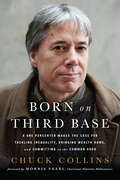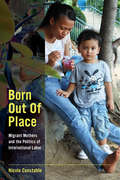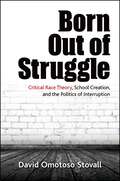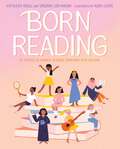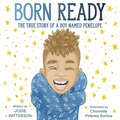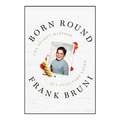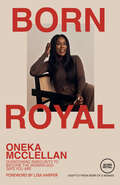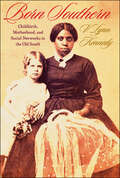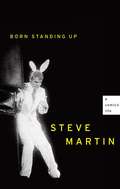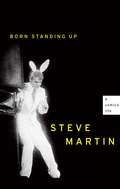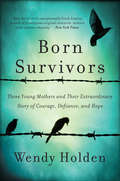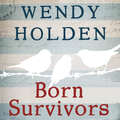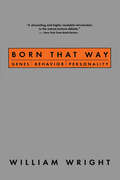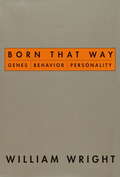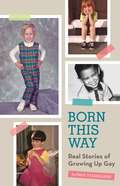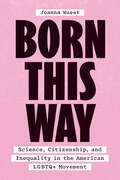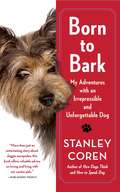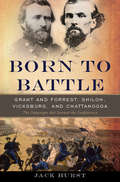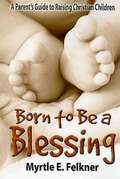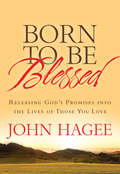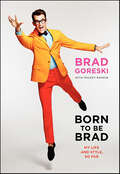- Table View
- List View
Born on Third Base: A One Percenter Makes the Case for Tackling Inequality, Bringing Wealth Home, and Committing to the Common Good
by null Chuck Collins&“A call to action for America's wealthy and a warning shot across the bows of their yachts if they fail to act, Born on Third Base offers a clear and compelling case for why the privileged and powerful must act to reverse widening inequality of income, wealth, and political power in America.&”—Robert B. Reich, former US Secretary of Labor; author of Saving CapitalismAn essential piece of reading for anyone concerned by the increasing wealth inequality–made worse by the global pandemic and political partisanshipThe growing wealth inequality continues to dominate headlines. The divide between the haves and have nots in America is increasingly political and tensions are rising. On one side, the wealthy wield power and advantage, keeping the system operating in their favor―all while retreating into enclaves that separate them further and further from the poor and working class. On the other side, those who find it increasingly difficult to keep up or get ahead are desperate and frustrated ―waging a rhetorical war against the rich and letting anger and resentment keep us from seeing new potential solutions.But can we suspend both class wars long enough to consider a new way forward? Is it really good for anyone that most of society&’s wealth is pooling at the very top of the wealth ladder? Does anyone, including the one percent, really want to live in a society plagued by economicapartheid?It is time to think differently, says longtime inequality expert and activist Chuck Collins. Born into the one percent, Collins gave away his inheritance at 26 and spent the next three decades mobilizing against inequality. He uses his perspective from both sides of the divide to deliver anew narrative.Collins calls for a ceasefire and invites the wealthy to come back home, investing themselves and their wealth in struggling communities. And he asks the non-wealthy to build alliances with the one percent and others at the top of the wealth ladder.Stories told along the way explore the roots of advantage, show how taxpayers subsidize the wealthy, and reveal how charity, used incorrectly, can actually reinforce extreme inequality. Readers meet pioneers who are crossing the divide to work together in new ways, including residents in the author&’s own Boston-area neighborhood who have launched some of the most interesting community transition efforts in the nation.In the end, Collins&’s national and local solutions not only challenge inequality but also respond to climate change and offer an unexpected, fresh take on one of our most intransigent problems.
Born Out of Place
by Nicole ConstableHong Kong is a meeting place for migrant domestic workers, traders, refugees, asylum seekers, tourists, businessmen, and local residents. In Born Out of Place, Nicole Constable looks at the experiences of Indonesian and Filipina women in this Asian world city. Giving voice to the stories of these migrant mothers, their South Asian, African, Chinese, and Western expatriate partners, and their Hong Kong-born babies, Constable raises a serious question: Do we regard migrants as people, or just as temporary workers? This accessible ethnography provides insight into global problems of mobility, family, and citizenship and points to the consequences, creative responses, melodramas, and tragedies of labor and migration policies.
Born Out of Struggle: Critical Race Theory, School Creation, and the Politics of Interruption (SUNY series, Praxis: Theory in Action)
by David Omotoso StovallRooted in the initial struggle of community members who staged a successful hunger strike to secure a high school in their Chicago neighborhood, David Omotoso Stovall's Born Out of Struggle focuses on his first-hand participation in the process to help design the school. Offering important lessons about how to remain accountable to communities while designing a curriculum with a social justice agenda, Stovall explores the use of critical race theory to encourage its practitioners to spend less time with abstract theories and engage more with communities that make a concerted effort to change their conditions. Stovall provides concrete examples of how to navigate the constraints of working with centralized bureaucracies in education and apply them to real-world situations.
Born Reading: 20 Stories of Women Reading Their Way into History
by Kathleen Krull Virginia Loh-HaganOnce books kick-start their brains, girls change history. Discover the foundation of reading that empowered some of the world’s most influential women in this informative and inspirational illustrated middle grade collection of twenty biographies. <p><p> What do Cleopatra, Audre Lorde, and Taylor Swift have in common? They’re all influential women who grew up doing one very important thing: reading. <p><p> This collection of short-form biographies tells the story of twenty groundbreaking women and how their childhood reading habits empowered them to change the world. From Cleopatra to Sally Ride to Amanda Gorman, the women featured in this collection are from all throughout history and all kinds of backgrounds. They are women who have and who continue to change the game in STEM, literature, politics, sports, and more. Most importantly, they are women who were born to read. <p><p> For some, reading was forbidden, but they taught themselves to read anyway. For some, reading was a struggle, but they practiced and grew to love it. For some, reading was an escape from difficult realities. For all, reading was empowering.
Born Ready: The True Story of a Boy Named Penelope
by Jodie PattersonJodie Patterson, activist and Chair of the Human Rights Campaign Foundation Board, shares her transgender son's experience in this important picture book about identity and acceptance.Penelope knows that he's a boy. (And a ninja.) The problem is getting everyone else to realize it. In this exuberant companion to Jodie Patterson's adult memoir, The Bold World, Patterson shares her son Penelope's frustrations and triumphs on his journey to share himself with the world. Penelope's experiences show children that it always makes you stronger when you are true to yourself and who you really are.
Born Red
by Yuan GaoBorn Red is an artistically wrought personal account, written very much from inside the experience, of the years 1966-1969, when the author was a young teenager at middle school. It was in the middle schools that much of the fury of the Cultural Revolution and Red Guard movement was spent, and Gao was caught up in very dramatic events, which he recounts as he understood them at the time. Gao's father was a county political official who was in and out of trouble during those years, and the intense interplay between father and son and the differing perceptions and impact of the Cultural Revolution for the two generations provide both an unusual perspective and some extraordinary moving moments. He also makes deft use of traditional mythology and proverbial wisdom to link, sometimes ironically, past and present. Gao relates in vivid fashion how students-turned-Red Guards held mass rallies against 'capitalist roader' teachers and administrators, marching them through the streets to the accompaniment of chants and jeers and driving some of them to suicide. Eventually the students divided into two factions, and school and town became armed camps. Gao tells of the exhilaration that he and his comrades experienced at their initial victories, of their deepening disillusionment as they utter defeat as the tumultuous first phase of the Cultural Revolution came to a close. The portraits of the persons to whom Gao introduces us - classmates, teachers, family members - gain weight and density as the story unfolds, so that in the end we see how they all became victims of the dynamics of a mass movement out of control.
Born Round: The Secret History of a Full-Time Eater
by Frank BruniThe New York Times restaurant critic's heartbreaking and hilarious account of how he learned to love food just enough <P><P> Frank Bruni was born round. Round as in stout, chubby, and always hungry. His relationship with eating was difficult and his struggle with it began early. When named the restaurant critic for The New York Times in 2004, he knew he would be performing one of the most watched tasks in the epicurean universe. And with food his friend and enemy both, his jitters focused primarily on whether he'd finally made some sense of that relationship. A captivating story of his unpredictable journalistic odyssey as well as his lifelong love-hate affair with food, Born Round will speak to everyone who's ever had to rein in an appetite to avoid letting out a waistband.
Born Royal: Overcoming Insecurity to Become the Woman God Says You Are
by Oneka McClellanA revolution for women to live confidently in their God-given identity and united in the call to bring goodness to the world, adapted from Born of a Woman, from speaker and pastor of the influential Shoreline City Church.&“In these pages, you will experience the beauty of a friend who says, &‘Royal sister, take a seat. We have been waiting for you!&’&”—Charlotte Gambill, pastor, author, and global Bible teacherWe know women are meant to bring powerful and lasting goodness into the world because God repeatedly called women to do so: He trusted Mary to give birth to Jesus, Esther to save His people, and Deborah to lead His kingdom. Yet so much of our potential is limited by our own insecurity and fear. It&’s time for us to stand confident in our stunning worth as royal daughters, unite in community, and walk in the unshakable hope of Christ. In a message that&’s both vibrant and conversational, Pastor Oneka McClellan reminds us that God has uniquely positioned and gifted women to be a source of life, wisdom, and strength. Through insightful biblical truths and real stories of women showing up in powerful ways, McClellan equips you to• completely trust your God-given identity• lead with courage and wisdom in any room • fight for the flourishing of others• celebrate the greatness in every woman• see with eyes of hope that God can redeem any storyTo every woman who&’s ever felt held back, pushed down, or disqualified from stepping fully into her purpose, McClellan&’s Born Royal offers hope, encouragement, and empowerment. It also sounds a liberating call for each and every one of us—including you—to walk boldly and precisely as the women God has created us to be.
Born Southern: Childbirth, Motherhood, and Social Networks in the Old South
by V. Lynn KennedyIn Born Southern, V. Lynn Kennedy addresses the pivotal roles of birth and motherhood in slaveholding families and communities in the Old South. She assesses the power structures of race, gender, and class—both in the household and in the public sphere—and how they functioned to construct a distinct antebellum southern society. Kennedy’s unique approach links the experiences of black and white women, examining how childbirth and motherhood created strong ties to family, community, and region for both. She also moves beyond a simple exploration of birth as a physiological event, examining the social and cultural circumstances surrounding it: family and community support networks, the beliefs and practices of local midwives, and the roles of men as fathers and professionals. The southern household—and the relationships among its members—is the focus of the first part of the book. Integrating the experiences of all women, black and white, rich and poor, free and enslaved, these narratives suggest the complexities of shared experiences that united women in a common purpose but also divided them according to status. The second part moves the discussion from the private household into the public sphere, exploring how southerners used birth and motherhood to negotiate public, professional, and political identities. Kennedy’s systematic and thoughtful study distinguishes southern approaches to childbirth and motherhood from northern ones, showing how slavery and rural living contributed to a particularly southern experience.
Born Southern: Childbirth, Motherhood, and Social Networks in the Old South
by V. Lynn KennedyA social history of childbearing and motherhood focused on black and white women in slave-owning households in the antebellum and Civil War South.In Born Southern, V. Lynn Kennedy addresses the pivotal roles of birth and motherhood in slaveholding families and communities in the Old South. She assesses the power structures of race, gender, and class—both in the household and in the public sphere—and how they functioned to construct a distinct antebellum southern society.Kennedy’s unique approach links the experiences of black and white women, examining how childbirth and motherhood created strong ties to family, community, and region for both. She also moves beyond a simple exploration of birth as a physiological event, examining the social and cultural circumstances surrounding it: family and community support networks, the beliefs and practices of local midwives, and the roles of men as fathers and professionals.The southern household—and the relationships among its members—is the focus of the first part of the book. Integrating the experiences of all women, black and white, rich and poor, free and enslaved, these narratives suggest the complexities of shared experiences that united women in a common purpose but also divided them according to status. The second part moves the discussion from the private household into the public sphere, exploring how southerners used birth and motherhood to negotiate public, professional, and political identities.Kennedy’s systematic and thoughtful study distinguishes southern approaches to childbirth and motherhood from northern ones, showing how slavery and rural living contributed to a particularly southern experience.
Born Standing Up: A Comic's Life
by Steve MartinAutobiography by the 'wild and crazy guy' himself, how he was the biggest name in stand-up comedy in 1978, and how he walked away from it forever in 1981.
Born Standing Up: A Comic's Life (Thorndike Core Ser.)
by Steve MartinThe riveting, mega-bestselling, beloved and highly acclaimed memoir of a man, a vocation, and an era named one of the ten best nonfiction titles of the year by Time and Entertainment Weekly.In the mid-seventies, Steve Martin exploded onto the comedy scene. By 1978 he was the biggest concert draw in the history of stand-up. In 1981 he quit forever. This book is, in his own words, the story of “why I did stand-up and why I walked away.” Emmy and Grammy Award–winner, author of the acclaimed New York Times bestsellers Shopgirl and The Pleasure of My Company, and a regular contributor to The New Yorker, Martin has always been a writer. His memoir of his years in stand-up is candid, spectacularly amusing, and beautifully written. At age ten Martin started his career at Disneyland, selling guidebooks in the newly opened theme park. In the decade that followed, he worked in the Disney magic shop and the Bird Cage Theatre at Knott’s Berry Farm, performing his first magic/comedy act a dozen times a week. The story of these years, during which he practiced and honed his craft, is moving and revelatory. The dedication to excellence and innovation is formed at an astonishingly early age and never wavers or wanes. Martin illuminates the sacrifice, discipline, and originality that made him an icon and informs his work to this day. To be this good, to perform so frequently, was isolating and lonely. It took Martin decades to reconnect with his parents and sister, and he tells that story with great tenderness. Martin also paints a portrait of his times—the era of free love and protests against the war in Vietnam, the heady irreverence of The Smothers Brothers Comedy Hour in the late sixties, and the transformative new voice of Saturday Night Live in the seventies. Throughout the text, Martin has placed photographs, many never seen before. Born Standing Up is a superb testament to the sheer tenacity, focus, and daring of one of the greatest and most iconoclastic comedians of all time.
Born Survivors: Three Young Mothers and Their Extraordinary Story of Courage, Defiance, and Hope
by Wendy HoldenAmong the millions of Holocaust victims sent to Auschwitz II-Birkenau in 1944, Priska, Rachel, and Anka each pass through its infamous gates with a secret. Strangers to one another, they are newly pregnant, and facing an uncertain fate without their husbands. Alone, scared, and with so many loved ones already lost to the Nazis, these young women are privately determined to hold on to all they have left: their lives and those of their unborn babies.That the gas chambers ran out of Zyklon B just after the babies were born, before they and their mothers could be exterminated, is just one of several miracles that allowed them all to survive and rebuild their lives after World War II. Born Survivors follows the mothers' incredible journey--first to Auschwitz, where they each came under the murderous scrutiny of Dr. Josef Mengele; then to a German slave-labor camp, where, half-starved and almost worked to death, they struggled to conceal their condition; and, finally, as the Allies closed in, their hellish seventeen-day train journey with thousands of other prisoners to the Mauthausen death camp in Austria. Biographer Wendy Holden details the courage and kindness of strangers, including guards and civilians, which helped save these women and their children.Sixty-five years later, the three "miracle babies" meet for the first time at Mauthausen for the anniversary of the American liberation. United by their remarkable experiences of survival against all odds, they come to consider each other "siblings of the heart." In Born Survivors, Holden brings all three stories together for the first time, to mark their seventieth birthdays and the seventieth anniversary of the ending of the war.A heart-stopping account of how three mothers and their newborns fought to survive the Holocaust, Born Survivors is also a life-affirming celebration of our capacity to care and love amid inconceivable cruelty.
Born Survivors: The incredible true story of three pregnant mothers and their courage and determination to survive in the concentration camps
by Wendy HoldenThe Sunday Times bestseller now updated with a new forewordAmong millions of Holocaust victims sent to Auschwitz II-Birkenau in 1944, Priska, Rachel, and Anka each passed through its infamous gates with a secret. Strangers to each other, they were newly pregnant, and facing an uncertain fate without their husbands. Alone, scared, and with so many loved ones already lost to the Nazis, these young women were privately determined to hold on to all they had left: their lives, and those of their unborn babies.That the gas chambers ran out of Zyklon-B just after the babies were born, before they and their mothers could be exterminated, is just one of several miracles that allowed them all to survive and rebuild their lives after World War II. Born Survivors follows the mothers' incredible journey - first to Auschwitz, where they each came under the murderous scrutiny of Dr. Josef Mengele; then to a German slave labour camp where, half-starved and almost worked to death, they struggled to conceal their condition; and finally, as the Allies closed in, their hellish 17-day train journey with thousands of other prisoners to the Mauthausen death camp in Austria. Hundreds died along the way but the courage and kindness of strangers, including guards and civilians, helped save these women and their children.Sixty-five years later, the three 'miracle babies' met for the first time at Mauthausen for the anniversary of the liberation that ultimately saved them. United by their remarkable experiences of survival against all odds, they now consider each other "siblings of the heart." In Born Survivors, Wendy Holden brings all three stories together for the first time to mark their seventieth birthdays and the seventieth anniversary of the ending of the war.A heart-stopping account of how three mothers and their newborns fought to survive the Holocaust, Born Survivors is also a life-affirming celebration of our capacity to care and to love amid inconceivable cruelty.
Born Survivors: The incredible true story of three pregnant mothers and their courage and determination to survive in the concentration camps
by Wendy HoldenThis recording includes an exclusive interview with Eva Clarke who was born in the Mauthausen death campAmong millions of Holocaust victims sent to Auschwitz II-Birkenau in 1944, Priska, Rachel, and Anka each passed through its infamous gates with a secret. Strangers to each other, they were newly pregnant, and facing an uncertain fate without their husbands. Alone, scared, and with so many loved ones already lost to the Nazis, these young women were privately determined to hold on to all they had left: their lives, and those of their unborn babies.That the gas chambers ran out of Zyklon-B just after the babies were born, before they and their mothers could be exterminated, is just one of several miracles that allowed them all to survive and rebuild their lives after World War II. Born Survivors follows the mothers' incredible journey - first to Auschwitz, where they each came under the murderous scrutiny of Dr. Josef Mengele; then to a German slave labour camp where, half-starved and almost worked to death, they struggled to conceal their condition; and finally, as the Allies closed in, their hellish 17-day train journey with thousands of other prisoners to the Mauthausen death camp in Austria. Hundreds died along the way but the courage and kindness of strangers, including guards and civilians, helped save these women and their children.Sixty-five years later, the three 'miracle babies' met for the first time at Mauthausen for the anniversary of the liberation that ultimately saved them. United by their remarkable experiences of survival against all odds, they now consider each other "siblings of the heart." In Born Survivors, Wendy Holden brings all three stories together for the first time to mark their seventieth birthdays and the seventieth anniversary of the ending of the war.A heart-stopping account of how three mothers and their newborns fought to survive the Holocaust, Born Survivors is also a life-affirming celebration of our capacity to care and to love amid inconceivable cruelty.
Born That Way: Genes, Behavior, Personality
by William WrightTaking the nature vs. nurture debate to a new level, this fascinating, comprehensive journey into the world of genetic research and molecular biology offers a fresh assessment of the work that has been done in this relatively new field during the last half century-work that has demolished common assumptions and overturned existing theories about what determines our personality and behavior.
Born That Way
by William WrightTaking the nature vs. nurture debate to a new level, this fascinating, comprehensive journey into the world of genetic research and molecular biology offers a fresh assessment of the work that has been done in this relatively new field during the last half century-work that has demolished common assumptions and overturned existing theories about what determines our personality and behavior.
Born This Way: Real Stories of Growing Up Gay
by Paul VitaglianoBased on the hugely popular blog of the same name, Born This Way shares 100 different memories of growing up LGBTQ. Childhood photographs are accompanied by sweet, funny, and at times heartbreaking personal stories. Collected from around the world and dating from the 1940s to today, these memories speak to the hardships of an unaccepting world and the triumph of pride, self-love, and self-acceptance. This intimate little book is a wonderful gift for all members of the LGBTQ community as well as their friends and families. Like Dan Savage's It Gets Better Project, Born This Way gives young people everywhere the courage to say, "Yes, I'm gay. And I was born this way. I've known it since I was very young, and this is my story."
Born This Way: Science, Citizenship, and Inequality in the American LGBTQ+ Movement
by Joanna WuestThe story of how a biologically driven understanding of gender and sexuality became central to US LGBTQ+ political and legal advocacy. Across protests and courtrooms, LGBTQ+ advocates argue that sexual and gender identities are innate. Oppositely, conservatives incite panic over “groomers” and a contagious “gender ideology” that corrupts susceptible children. Yet, as this debate rages on, the history of what first compelled the hunt for homosexuality’s biological origin story may hold answers for the queer rights movement’s future. Born This Way tells the story of how a biologically based understanding of gender and sexuality became central to LGBTQ+ advocacy. Starting in the 1950s, activists sought out mental health experts to combat the pathologizing of homosexuality. As Joanna Wuest shows, these relationships were forged in subsequent decades alongside two broader, concurrent developments: the rise of an interest-group model of rights advocacy and an explosion of biogenetic and bio-based psychological research. The result is essential reading to fully understand LGBTQ+ activism today and how clashes over science remain crucial to equal rights struggles.
Born to Bark
by Stanley Coren"For Christmas the woman who would become my wife bought me a dog--a little terrier. The next year her Christmas gift to me was a shotgun. Most of the people in my family believe that those two gifts were not unrelated." So begins Born to Bark, the charming new memoir by psychologist and beloved dog expert Stan Coren of his relationship with an irrepressible gray Cairn terrier named Flint. Stan immediately loved the pup for his friendly nature and indefatigable spirit, though his wife soon found the dog's unpredictable exuberance difficult to deal with, to say the least. Even though Flint drove Stan's wife up the wall, he became the joy of Stan's life. The key to unlocking this psychologist-author's way of looking at dog behavior, Flint also became the inspiration behind Coren's classic, The Intelligence of Dogs. Undeterred by Flint's irrepressible behavior (and by the breeder's warning that he might be untrainable), Coren set out to prove that his furry companion could pass muster with the best of them. He persevered in training the unruly dog and even ventured into the competitive circles of obedience trials in dog shows, where Flint eventually made canine history as the highest-scoring Cairn terrier in obedience competition up to that time. (Stan chose not to tell his wife that the highest-ranking obedience dog of that year, a border collie, earned a total score that was fifty times higher.) The longest-running popular expert on human-dog bonding, Coren has enlivened his respected books and theories about dogs with accounts of his own experiences in training, living with, loving, and trying to understand them. A consummate storyteller, Coren now tells the wry, poignant, goofy, and good-hearted tale of his life with the dog who (in the words of his own book titles) taught him How to Speak Dog and How Dogs Think and whose antics made him ask Why Does My Dog Act That Way? Illustrated with Coren's own delightful line drawings and photos, and interwoven with his heartfelt anecdotes of other beloved dogs from his earlier life, Born to Bark is an irresistible good dog/bad dog tale of this extraordinary, willful pooch and his profound impact on his master's insights into canine behavior as a research psychologist and on his outlook on life as a whole.
Born to Battle: Grant and Forrest--Shiloh, Vicksburg, and Chattanooga
by Jack HurstBorn to Battleexamines the Civil War’s complex and decisive western theater through the exploits of its greatest figures, Ulysses S. Grant and Nathan Bedford Forrest. These two opposing giants squared off in some of the most epic campaigns of the war, starting at Shiloh and continuing through Perryville, Vicksburg, Chickamauga, and Chattanooga-battles in which the Union would slowly but surely divide the western Confederacy, setting the stage for the final showdowns of the bloody, protracted conflict. Grant is widely regarded as the man most responsible for winning the war for the Union, Forrest as the Confederacy’s most fearsome defender in the West. Both men had risen through their respective hierarchies thanks to their cunning and military brilliance, and despite their checkered pasts. Grant and Forrest were both "lower”-born officers who struggled to overcome particular, dubious reputations (Forrest’s as a semi-literate rustic and Grant’s as a doltish drunkard). In time, however each became renowned for his intelligence, resourcefulness, and grit. Indeed, as Hurst shows, their familiarity with hardship gave both men a back-against-the-wall mindset that would ultimately determine their success-both on the battlefield, and off it. Beginning with the Union victory at Tennessee’s Fort Donelson in February 1862 (when Grant handed the Union the largest force ever captured on American soil, refurbishing his reputation and earning himself the nickname "Unconditional Surrender Grant”), Hurst follows both men through the campaigns of the next twenty months, showing how this critical period-and these two unequaled leaders-would change the course of the war. Again and again, Grant’s hardscrabble tactics saved Federal forces from the disastrous decisions of his fellow commanders, who seemed unable to think outside of the West Point playbook. Just as often, Forrest’s hot temper and wily, frontier know-how would surprise his Federal adversaries and allow him to claim astonishing victories on behalf of the Confederacy. But as Grant pressed south and east over the course of these twenty months, routing Confederate forces at such critical strongholds as Corinth, Vicksburg ("Gibraltar of the Mississippi”), and Chattanooga, the systemic differences between the North and South began to tell. The more inclusive, meritocratic Union allowed Grant to enter into the military’s halls of decision, whereas the proudly aristocratic Confederate high command barred Forrest from contributing his input. As Hurst vividly demonstrates, that disparity affected, and possibly dictated, the war’s outcome. Thoroughly disgusted with his disdainful superiors and their failure to save his home state of Tennessee from the clutches of the Union, Forrest eventually requested a transfer to a backwater theater of the war. Grant, by contrast, won command of the entire Union army following his troops’ stunning performance at Chattanooga, and would go on to lead the North to victory over the forces of another exceptional Southern general: Robert E. Lee. An utterly American tale about class, merit, and their role in one of the most formative wars in the nation’s history,Born to Battleoffers an impassioned account of two visionary Civil War leaders and the clashing cultures they fought-in some cases, quite ironically-to protect. Hurst shows how Grant and Forrest brought to the battlefield the fabled virtues of the American working-class: hard work, ingenuity, and intense determination. Each man’s background contributed to his triumphs on the battlefield, but the open-mindedness of his fellow commanders proved just as important. When the North embraced Grant, it won a stalwart defender. When the South rejected Forrest, by contrast, it sealed its fate.
Born to Be a Blessing: A Parent's Guide to Raising Christian Children
by Myrtle FelknerEvery child is born to be a blessing. Many parents experience overwhelming love when their children are born, and strive to raise their children to experience a relationship with God through Jesus Christ. This guide for parents enables them study, learn, and grow together to find answers to shared questions and concerns as they raise their children. Parents will deal with many areas of children's lives such as self-control, truth-telling, sibling rivalry, generosity, and making faithful decisions. Perfect for small groups, each session includes Scripture, plus stories, and questions for meditation and discussion. Parents learn new tools to respond to their children in positive, Christ-like ways, and gives them the courage to face one of the most blessed jobs of all -- raising Christian children.
Born to Be Awkward: Celebrating Those Imperfect Moments of Babyhood
by Mike Bender Doug ChernackFrom the folks who brought us the bestselling Awkward Family Photos series comes a tribute to those awkward early years of life. Our first few years are the most photographed time of our lives. Our parents document every milestone and then feel compelled to share these photos with the world. The only problem is, we haven't developed our motor skills and can't control our faces, or any other parts of our body for that matter. This, of course, leads to some of the most hilarious and unexpected family pictures. From our first post-delivery scowl, to our first throw-up, and yes, even to our first bikini--Born to Be Awkward is a celebration of what is literally the most uncomfortable stage of life.
Born to Be Blessed: Releasing God's Promises into the Lives of Those You Love
by John HageeThere are times when each of us struggle with the words to express our deepest prayers. With his signature style, Swindoll combines a prayer specific to each daily devotional and gently pastors readers through the issues life brings their way. This remarkably accessible study explores such themes as injustice, grace, gratitude, grief, guilt and much more.
Born to Be Brad: My Life and Style, So Far
by Brad Goreski Mickey RapkinCelebrity stylist and fashion icon Brad Goreski takes readers inside his whirlwind life, from his small-town Canadian roots to his worldwide successes, sharing a wealth of style tips, tricks, and photos along the way to help every reader look and feel their absolute best. Fans of The Rachel Zoe Project and It’s a Brad, Brad World already know that there’s no one on reality TV more fearless or savvy when it comes to style. But Born to Be Brad gives the world its first behind-the-scenes look at how Brad became the stylist he is. This is not just a how-to style book. It’s a sublimely written, riveting life story with the power to take you to the top of your fashion game—right along with Brad.
